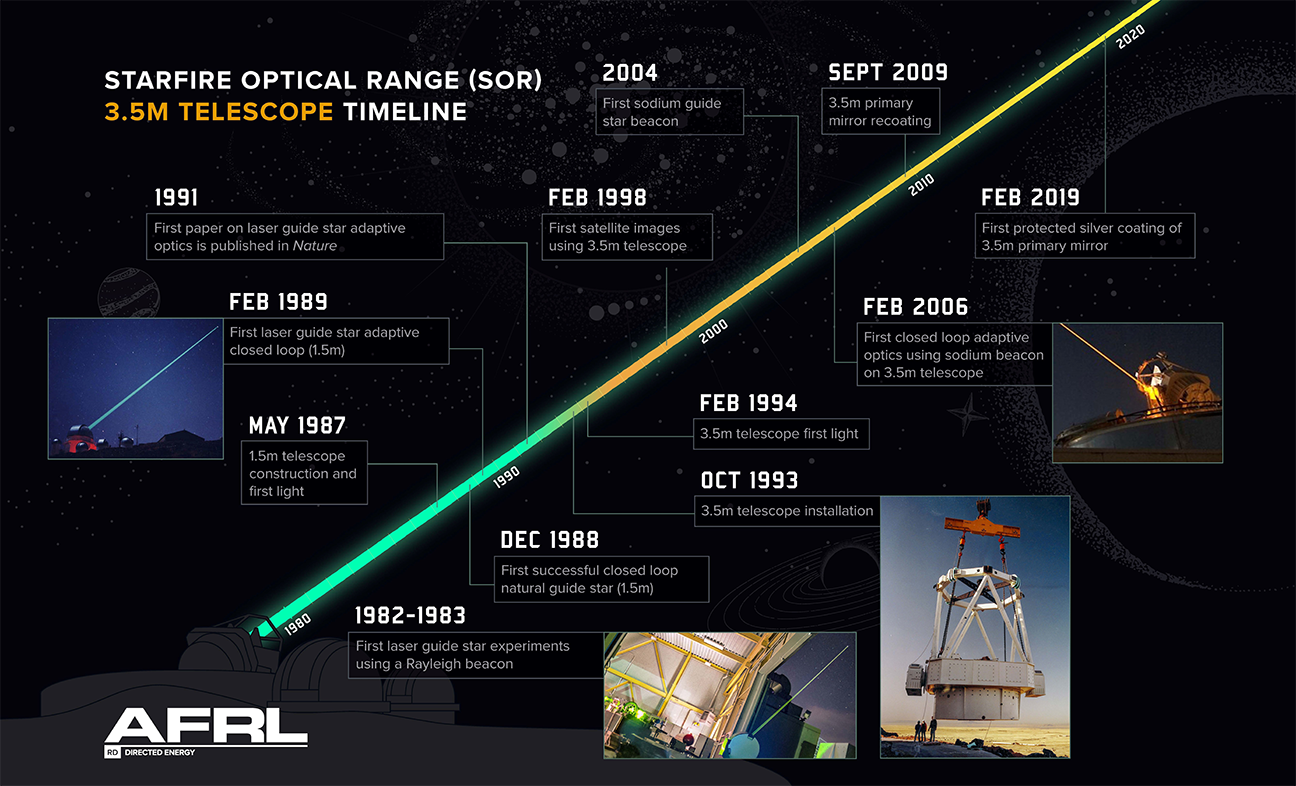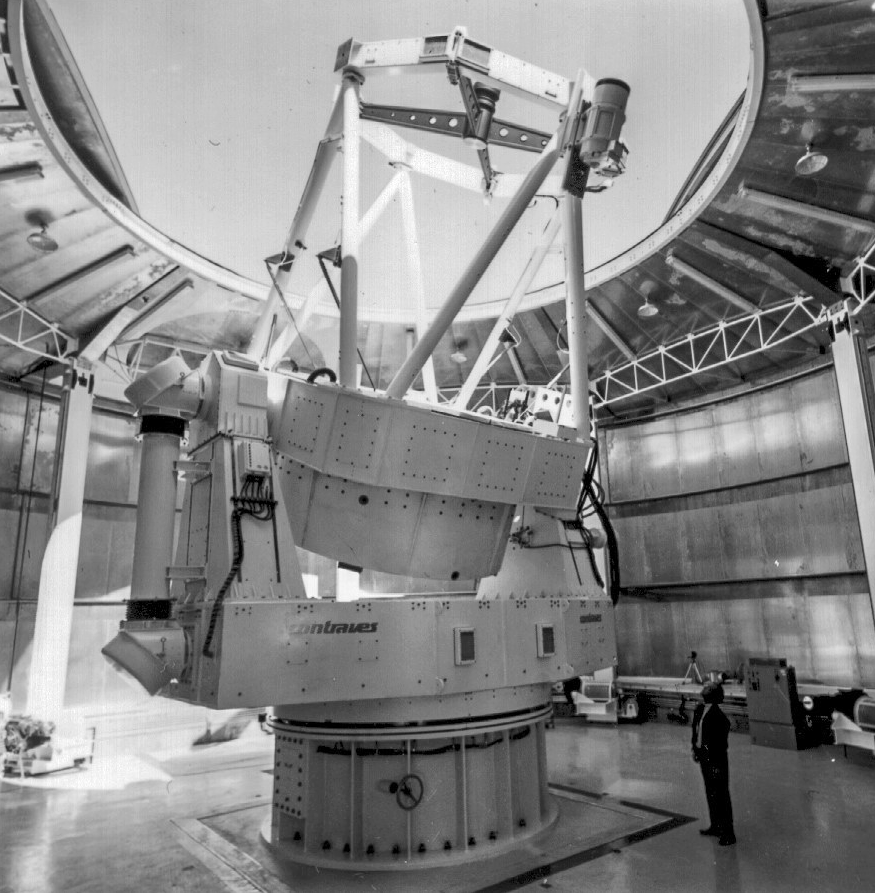Starfire Optical Range’s 3.5m telescope marks 30th anniversary of ‘First Light’
KIRTLAND AIR FORCE BASE, N.M. (AFRL) — The Air Force Research Laboratory, or AFRL, marked a milestone in space exploration Feb. 10, 2024, commemorating the 30th anniversary of the “First Light” images captured by the 3.5-meter telescope at the Starfire Optical Range, or SOR, Kirtland Air Force Base, N.M. Retired AFRL senior scientist, astronomer, physicist and senior executive Dr. Robert Q. Fugate, who worked for AFRL for over 40 years and whom the scientific community has coined “the father of adaptive optics and modern astronomy,” was integral in the development and installation of the telescope 30 years ago.
The telescope is the second largest in the DOD behind its sister 3.67-meter telescope at the Air Force Maui Optical and Supercomputing Site, or AMOS, and would go on to prove a capability that would have huge impacts around the world.

Dr. Dennis Montera, principal investigator, Air Force Research Laboratory Directed Energy Directorate, leads a tour of the telescope and laser guide star adaptive optics system in July 2010 at Starfire Optical Range, Kirtland Air Force Base, N.M. Montera explained to the Scientific Advisory Board that the rotating lights from the sodium laser control panels were mounted on the side of the telescope. (U.S. Air Force photo / Dr. Robert Q. Fugate)
In the fall of 1993, a 4,500-pound monolithic spun-cast borosilicate mirror had its telescope mount and mirror installed, capturing the inaugural image of a space object Feb. 10, 1994. Since that date and over the past three decades, the telescope has accelerated revolutionary developments in space awareness and imaging technologies featuring laser guide star, or LGS, adaptive optics, or AO, as an essential component for numerous space experiments.
Fugate, then working under AFRL’s Directed Energy Directorate’s SOR, recounted his experience developing Starfire.
“The morning after the day we installed the telescope in October 1993, I went up the hill [the base of Mount Fugate.], climbed the stairs into the dome and just looked at the telescope,” Fugate said. “I wanted to be sure the events of the preceding day weren’t a dream. Yes, it was really here, after a decade of planning, fighting for and justifying budget, design reviews, taking huge risks on the primary mirror and a gamble that a 100-ton mount could track satellites.”
Fugate said he recalled working with Dr. Roger Angel at the University of Arizona’s Steward Observatory on Angel’s inventions to spin-cast [where large parabolic mirrors for telescopes are constructed in a spinning furnace] to an audience of students and staff in Tucson on the University of Arizona campus during his quest to get a telescope even larger than the first 1.5-meter telescope installed in May 1987.
“I was a bit apprehensive because I didn’t know how a member of the military would be received,” Fugate said.
Not knowing what to expect, Fugate was pleasantly surprised when he developed a lasting friendship with Angel. “Taking risks is essential for breakthroughs in research and development,” he said.
This relationship led to the AFRL-funded revolutionary polishing technique called stressed lap polishing, a solution to the fundamental problem of shape misfit that occurs for large polishing tools on highly aspheric optical surfaces in the 3.5-meter primary mirror developed by 1992.

A timeline showing significant milestones in the Starfire Optical Range, or SOR, history of the last 30 years. The SOR at Kirtland Air Force Base, N.M., celebrated its 30th anniversary Feb. 10, 2024. (U.S. Air Force graphic/ Gregory Gerken)
Col. Kathryn Cantu, division chief, Space Electro Optics division, described Fugate as the “father of adaptive optics.”
“Fugate … took the ideas of the astronomy community that had been working for hundreds of years with preexisting telescope technology, which loses its effectiveness through the atmosphere, and instead envisioned using this idea of adaptive optics, and developed Starfire,” Cantu said.
Cantu explained that the advances made in the last 30 years are exponential compared to the telescopes used for the last 400 years since Galileo.
“These systems [AO] are now used by astronomers worldwide, but more importantly, we’re now able to use them to support the USSF to detect and image what’s happening in space, without having to launch another satellite to do it,” Cantu said.
In the 1980s, researchers at SOR introduced the use of laser guide stars on telescopes, first on a 1.5-meter, then on a larger 3.5-meter. They began using Rayleigh beacon guide stars in 1982, later adding sodium beacon guide stars in 2004, according to Fugate and other members of the SOR team.
When objects being observed aren’t bright enough, a low power green laser can create a “guide star” by reflecting light off of the air through a process known as Rayleigh scattering. Another method involves stimulating atoms in the sodium layer of the mesosphere, using a yellow laser, to create guide stars at higher altitudes. It was through Fugate’s work and previous discoveries that this method of ‘laser guide star AO’ came about.
“The first sodium guide star laser was installed on the 3.5-meter telescope back in 2004,” said Dr. Dennis Montera, principal investigator, AFRL Directed Energy Directorate. “Since then, I have probably observed on-sky over 1,000 times both through testing and tours. While giving tours, what I tell my guests is ‘you are never going to forget seeing this.’ They then usually ask if I get tired of it. My truthful response: ‘I have been watching it for almost 20 years and I never get tired of seeing it.'”
These AO techniques were then refined and made practical by AFRL research at the SOR from 1987-2008 by correcting distortions caused by the Earth’s atmosphere in real time, helping all larger telescopes see space more clearly.

Retired Dr. Robert Q. Fugate, Air Force Research Laboratory senior scientist, astronomer, physicist and senior executive, stands in front of the telescope at Starfire Optical Range, Kirtland Air Force Base, N.M., November 1993. Fugate worked for AFRL for over 40 years and was integral in the development and installation of the telescope 30 years ago. (Courtesy photo)
“As satellites get smaller and the number of space objects increases, research in imaging and identification of space objects is paramount to meeting the Space Force’s mission.,” the SOR fact sheet states. Guide star AOs are now essential for use in today’s telescopes, some measuring up to 25 to 39 meters.
Dr. Darren Raspa, Space Vehicles Directed Energy Historian, said that at the dedication of the 3.5-meter telescope in 1994, the famous theme song to “2001: A Space Odyssey” played for the audience.
“This was perfect because, since that day 30 years ago, SOR has achieved a number of milestones supporting the advancement of knowledge of the orbital and deeper space environments,” said Raspa. “The work of Dr. Fugate and his team and the development of adaptive optics really illustrates the vision Gen. Hap Arnold [the only U.S. Air Force general to hold a five-star rank in two different U.S. military services including the U.S. Army, and who oversaw the growth of the Army Air Force through both World Wars] and Theodore von Kármán, had for science and technology playing a fundamental role in future Air Force—and now Space Force — strategic planning.”
In January 2021, AFRL SOR researcher Dr. Jack Drummond discovered a small satellite, named Olympias, orbiting around the asteroid Roxane. Drummond made this discovery using adaptive optics and a sodium laser, technologies that were pioneered and refined at the SOR. It was a sighting Drummond, and his team did not anticipate. Their results were published in “Icarus,” the Journal of Solar System Studies, per the SOR fact sheet.
Now reaching its 30th year of service, the 3.5-meter telescope remains a leader in research and innovation in space imaging technology within AFRL’s Directed Energy Space Electro-Optics division. The division continues to support U.S. Department of the Air Force missions in space domain awareness, imaging and tracing, and plans to continue for the foreseeable future.
About AFRL
The Air Force Research Laboratory is the primary scientific research and development center for the Department of the Air Force. AFRL plays an integral role in leading the discovery, development, and integration of affordable warfighting technologies for our air, space and cyberspace force. With a workforce of more than 12,500 across nine technology areas and 40 other operations across the globe, AFRL provides a diverse portfolio of science and technology ranging from fundamental to advanced research and technology development. For more information, visit www.afresearchlab.com.
